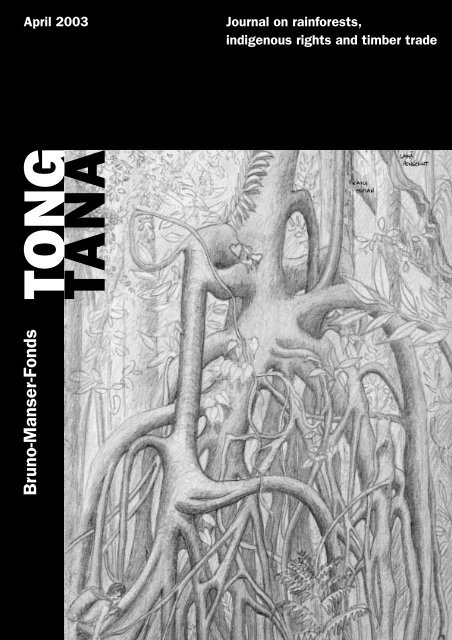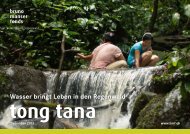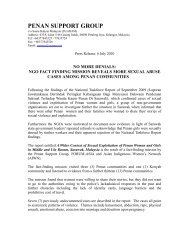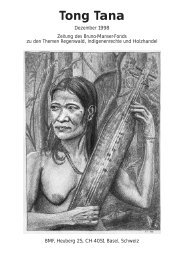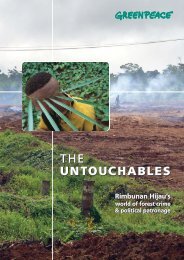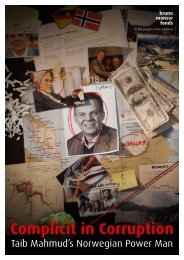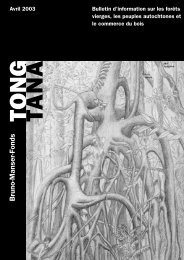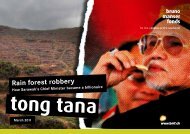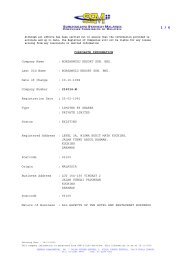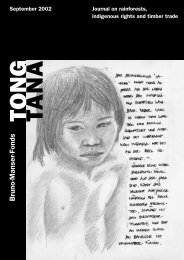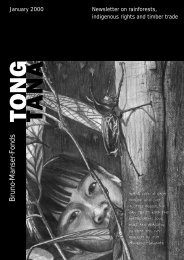pdf - Bruno Manser Fonds
pdf - Bruno Manser Fonds
pdf - Bruno Manser Fonds
- No tags were found...
You also want an ePaper? Increase the reach of your titles
YUMPU automatically turns print PDFs into web optimized ePapers that Google loves.
April 2003Journal on rainforests,indigenous rights and timber trade<strong>Bruno</strong>-<strong>Manser</strong>-<strong>Fonds</strong>
Sarawak-MalaysiaPrivatisation of the forestsjk – When Abdul Taib Mahmud was elected ChiefMinister in 1981, the election campaign was accompaniedby a stage-managed mud fight against hispredecessor and uncle. Each accused the other ofcorruption and leaked documents to the media thatproved that both candidates had been guilty of unlawfulmoneymaking. Even back then, the forest proved tobe the most lucrative self-service store. The concessionsand deforestation licences handed out shamelesslyto family and friends formed the basis of theimmense wealth of the Sarawak elite, leading to asituation, still prevalent today, whereby politicalcronies rule and control the entire national economy ofSarawak – from the construction sector to agriculture(palm oil), to the service sector and the media industry.In 2001, Taib Mahmud, elected to his fifth fiveyearterm as Chief Minister, indicated that 10% ofSarawak’s jungle was still intact – big business thereforeseems to be a thing of the past. But now, the governmenthas found plans dating from the early 90 s thatset out to privatise the entire Forestry Department.Law enforcement will be ensured by fewer than twelvegovernment officials, while the around 2000 forestryemployees have been offered employment with thenew company or a transfer to another GovernmentDepartment. Most of this drastic undertaking hasbeen carried out behind closed doors and is set toenter into force on the 1 st of April 2003. The governmentthus gives up almost all of its responsibility!Sustainability in Sarawak: „Due to shortage ofseedlings ...Only the Opposition Party DAP (Democratic ActionParty) fought against the undertaking: “Sarawak’sforests, environment and resources belong to allSarawakians and can therefore not be privatised butshould be prudently managed by the government in theinterest of all. It is unwise and imprudent to privatisea Government Department where public interest is involved.These functions ought to be managed by theGovernment as trustees of the people!”The history books tell us that only the corrupt eliteprofit from privatisation – especially as most of thetime projects are awarded without public calls for tender.In order to fight against corruption, DAP also callsfor greater transparency and accountability during theaward of government projects. “Even if there were meritsin privatising certain operations (not departments),it is DAP’s stance that the State Government shouldconsider other alternatives to improve the forestryeconomy such as certification for example”.Source: www.dapsarawak.com, 12.12.2002… and natives who illegaly occupy the land, our reafforestation activities face big problems”, saidSamling-Boss and Sarawak Timber Association’s Chairman Datuk Leo Chai at the annual general meeting ofthe STA on march 18, 2003.3 Tong Tana April 2003
Sarawak-Malaysia4 Tong Tana April 2003Hopefully trees keep growing into the skies –also for the Penan! Majestic tree in the upperLimbang-area, june 2002.Penan take the Government andSamling Co. to courtjk – On the 4 th of January 2003, in the case KelasauNaan against Samling and the Government, a hearingtook place between the lawyers of the three parties.They discussed Samling’s application for authorisationfor two Kenyah long houses lying close to the plaintiffs,the Penan, as defence against the land right demandsof the 4 Penan settlements (see Tong Tana December2002). The court had not made any ruling on this matterat the time of going to press but it is conceivablethat Samling’s application will be rejected because ofvarious contradictions. In the meantime, some Kenyahhave realised that they are more often than not in thesame boat as the Penan (also in the literal sense)rather than in that of Samling and that they never hadany problems with them. That is why the Kenyah areseriously considering demanding their own land rightsfrom the Government and Samling instead of takingaction against their long-standing neighbours!A forest reserve for Penan-Nomads?jk – As the BMF found out locally in December 2002,the Forestry Department gave a positive response inJuly 2002 to a petition drawn up by the nomads of theBareh and Magoh river. The three groups of nomads,led by Guman Megut, Bujan Lawai and Tebaran Agus,were promised a common forest reserve of 5,000hectares. This would appear to be grounds for celebration.The fact that this apparently positive developmentonly came to light when the Penan nomads wentto the office of Sahabat Alam Malaysia in Marudi atthe beginning of December in order to report on themassive incursion of forestry companies (includingSamling), and to ask for help, means that all hope fora change for the better can be forgotten once again.While the nomads may have been given a map with theextension of the forest reserve, this is so vague andhand drawn that it is not possible to speak of an actualend to timbering. Furthermore, the actual legal bindingforce of this proposal is unclear even though it hasbeen signed by the Forestry Department. A third of the“reserve” has furthermore already been “selectively”deforested over the past few years and a further thirdof this reserve, which is in any case too small, is currentlybeing exploited. The majority of the Penan territoriesneighbouring the “reserve”, which share theirhunting and gathering grounds according to age old traditions,have also been devastated. In the catchmentarea of the Bareh and the Magoh river, the actualheartland of the Penan and <strong>Bruno</strong>’s friends, another30 nomadic Penan families with over 150 membersare still trying to survive according to the traditionalway of life. The Sarawak government, the ForestryDepartment in particular, has therefore once againmade empty promises and is playing the time game,as from the point of view of those who stand to profitfrom the forest, once the conditions are created i.e.once the forest is ruined, then the Penan problem isalso solved. And with the privatisation of the ForestryDepartment, this “forest reserve” will also end up inthe wastepaper basket.The BMF has financially compensated the 3 fightingnomad groups for their action and is planning, withinthe framework of the mapping project that is definitivelysupported by the association “Kunst für denTropenwald”, to complete the documentation on theirlegitimate land and customary rights this year. The aimis to allow at least two nomadic groups to take theircase to court as quickly as possible.The Mapping Projectjk – In order to gain an overview of the situation and todiscuss the timetable for the year 2003, in DecemberI travelled to Sarawak for 10 days and met all of theproject partners in 3 hot and sticky cities. Over thistime I obtained a very positive impression of the workcarried out and of what can be achieved through commitmentand cooperation. Steering this kind of largescaleproject through the tricky local currents (Know-How/Personnel, Techniques/Infrastructure, Financialresources, etc.) is not an easy undertaking. The resultoriented aim is necessary as far as we are concerned,in order to be able to guarantee the on-going financialsupport, but is also causing some headaches inSarawak, both because of the aforementioned deficienciesand because of the local way of living andthinking, which is not always accustomed to long termworking processes. The traditional subsistence economy(hunting and gathering, planting and harvesting ofrice fields), and the weather (rainy season) are alsoforcing the Penan again and again to reset their priorities.However, this 3-year project is on the right pathand the first phase will be completed by the middle ofthe year as planned.
Sarawak-MalaysiaReckless action by Robin Wood for the natives of Malaysia in Hamburg, february 13, 2002.5 Tong Tana April 2003Hamburg wants to recogniseMalaysian tropical wood certificatejk – In 1996 the Hamburg City Senate decided to onlyuse tropical wood bearing the FSC certificate forits public buildings (www.fscoax.org). As a member ofthe international climate alliance (www.climatealliance.org),the city also undertook to give its supportto the protection of the rain-forests and the rights ofindigenous people. However, on the 11 th of December2002, the Department of the Economy of the city ofHamburg invited Robin Wood, Greenpeace and WWF,as well as the trade union IG B.A.U., to a round tablediscussion on the matter. The NGOs were confrontedwith the already carefully drafted intention, alongsidethe FSC certificate authorising the State MalaysianCertificate for a probationary period of 2 years, as“Malaysia seems to be determined to steer its forestrypractices, which have been out of control over the pastfew years (close to overfelling), towards sustainabledevelopment” (a quotation by Folkhard Spangenberg,Hamburg City Senate). The fact that this completelydistorted perception of reality is shared by the umbrellaassociation of the entire German timber trade isnot surprising.Based on reports by the largest environmental andindigenous organisations in Malaysia and Sarawak,which withdrew from the Malaysian certification processin 2001, as all of their objections (such as the land andnative customary rights of the indigenous peoples, seewww.rengah.c2o.org) were ignored, the environmentaland worker federations declared their rejection of theproposal at the first meeting. But the Department ofthe Economy of the Conservative-controlled HamburgSenate (CDU/FDP/”Schill-Partei”) kept its head down,ignored the objections, and held on tightly to its originalidea and simply invited them to the next round tablediscussion. By means of an identical procedure,Malaysia has long since claimed that all relevant partiesare actively participating in the process. Despiteprotests, the Malaysian Timber Certification Council(MTCC) however repeatedly misused informal meetingsbetween it and the Forest Stewardship Council (FSC)as “proof” that the FSC recognised the Malaysiancertification process. However, that is not the case, aswithin the FSC system, the rights of the local indigenouspopulation groups override the interests of thetimber industry. And that is exactly what Malaysia is notready to do. To this must be added the fact that thepractical certification system of the industry refuses tobe controlled by an independent third party – anotherprerequisite for the FSC certification! The NGOs thereforedid not turn up at the on-going pseudo participativeround table talks on the 13 th of February, and instead,activists from Robin Wood climbed onto the roofof the Department of the Economy with the banner“Hamburg on the (de)forestation track”.The environmental organisations were able to preventa rapid endorsement of the proposal thanks to theirprotest. Now, the Department of the Economy hasanother trick up its sleeve and is ready to accept proposalsfor minimum standards – but it continues totemporarily recognise the MTCC. The die has not yetbeen cast – as long as subsidiaries of the most activeenvironmental and rain-forest organisations are inHamburg! But the protest must also be taken up outsideHamburg so that the Senate realises that the environmentalorganisations here and elsewhere will notaccept a tropical wood certificate for public procurementmarkets that does not unreservedly support theland rights of the forest people.Request protest postcards from:tropenwald@robinwood.deor join the “Save the Rain-forest” online protest onhttp://www.regenwald.org/new/aktuelles/hamburg/protmail.htm!
International6 Tong Tana April 2003Massive criticism of FSCjrd – The Forest Stewardship Council (FSC) awards itslabel to forest industries, timber works and traders“guaranteeing” the labelled wood products as derivingfrom environmentally appropriate, sustainable andsocially beneficial forest management. The BritishRainforest Foundation recently published a report*describing 9 cases from all over the world demonstratingserious flaws in the claims of the FSC and the necessityfor fundamental reforms if the FSC is to upholdits own standards and the public’s expectations. Negativeexamples such as that of an Indonesian teakplantation company’s certification being withdrawn(see Tong Tana, Aug. 2001, p. 6/7) harm the FSC’sreputation.According to the Rainforest Foundation the followingpoints undermine FSC’s performance:– Of greatest importance to the whole organisationis the accreditation contract which regulates therelationship to FSC certifiers and is only intendedfor internal use! The actual on-site controllers ofthe forest industries and sales routes are thecertifiers (for ex. SCS, Smart Wood) with FSCauthorisation, who award the label according totheir own specifications.Because of their economic significance thesecertifiers are hardly controlled, let alone punishedfor violations of the FSC principles and criteria.– The greater the area these “independent” certifierscan certify, the higher their income, which maylead to a conflict of interests with the strict FSCstandards. They do place conditions which must befulfilled by the to be certified company inside agiven time-span but are not interested in rejectingapplications for certification. Such admittancesbased on a sitting back and watching attitude leadin the best case to some future improvement intimber production, while the products are alreadysold with the FSC logo!– The certifiers differ in their interpretation andapplication of the FSC principles and criteria.Additionally, involved experts who control a companyon-site have no possibility of enforcing theirrecommendations (due to the requirements ofconfidentiality); decisions are made by the managementof the certifier.– Due to competition with other certification systems,usually issued by the industry, the FSC hasdecided on the strategy of speedily enlarging theirown areas which puts people under pressure,leads to the standards being undermined (for ex.the percent clause), and to promises beingaccepted instead of actual management improvements– generally putting quantity over quality. TheFSC standards are the strictest. It is thereforequite complex and expensive to attain the label.Therefore it will never be able to compete againstless strict labels as far as quantity is concerned.– Due to trade groups mainly supported by the WWF,who wish to sell only FSC wood products, a demandis being created which can hardly be satisfied withwood from good sources. Therefore the FSC certifiedforest areas must be enlarged in order tosupply enough FSC wood!– This system of principles and criteria lacks a clearunambiguous definition of “major failures” (oncompany level as well as due to governmental baseconditions) which prohibit certification.The initial interest in certification was caused byappeals to boycott tropical wood or wood productsfrom overexploitation: suppliers, government authoritiesand retailers wanted to go on offering a big rangeof wood products without continuously being confrontedby campaigns and complaints. But one of thefundamental problems in the certification of wood andwood products is that the additional profit margin isrelatively small. Therefore companies look for cheaplabels, or less strict certifiers, or even play one certifieroff against another.The authors reach the conclusion that in the course ofthe last couple of years the FSC has developed from anorganisation which fought for better forest managementinto a marketing tool for better sales of woodproducts. They propose massive reforms, for example,that the FSC office itself (together with teams on anational level) award the label and dispense with thecertifiers. They hope with these and other measuresfor greater transparency and more democracy in thedecision making.They also recommend that instead of following thegrowth maxim they should fulfil the function of amarket niche by guaranteeing that only really goodexamples of their strict principles are awarded the FSClabel.* S. Counsell & K.T. Loraas (2002): Trading in Credibility – The mythand reality of the Forest Stewardship Council. 159 p.Links:www.rainforestfoundationuk.org/FSC/RFA4REPORTfull.<strong>pdf</strong> orwww.rainforestfoundationuk.org/FSC/FSCReport.htmlwww.fscoax.orgwww.regenwald.org/<strong>pdf</strong>/rdr-report0301.<strong>pdf</strong>
InternationalThe FSC answersjrd – According to a recent analysis** “almost all theissues raised by RF as matters of concern were wellknown to the responsible FSC staff … We do not thinkthey are intentional or incorrigible failures of certification”.However, the FSC secretariat acknowledges thatfurther improvements are needed.FSC has chosen to operate as an accreditationorganization for reasons of efficiency. Operating as acertification body would hardly improve the decisions.However, FSC would like to be able to monitor andco-ordinate more closely the work and systems ofaccredited firms without imposing unacceptable extracosts on certification.FSC states that their own evaluations were not able tosubstantiate the claims to deliberate manipulationand/or collusion between forest managers and certificationbodies, and it rejects the suggestion that staffis unable or unwilling to monitor or enforce adequatecompliance with the stated rules. And “fast growth” issaid to be desirable only within the framework of theFSC Principles & Criteria.Trade networks and their respective demand for productsare considered an immense support to FSC andcritical for its continued success.The secretariat prefers to give guidance on how to satisfythe rules, instead of insisting on (internationallydefined) “major failures” excluding any certification byFSC. These should be agreed upon on a national level.The analysis of the secretariat is sound, often verydetailed, and recognizes many shortcomings withinthe FSC-System, but disturbing is to read about themany very recent improvements and to see all theclarifications (requiring many consultations with a lotof FSC-bodies) which are just being elaborated.** H. Liedeker (2003): An FSC Analysis of the Rainforest Foundationreport, “Trading in Credibility”. 26 p.Cut – but not by him! Ulu Limbang, 1999Penan children still live in the forest; Ulu Limbang,august 2002.7 Tong Tana April 2003The BMF attitudeThe BMF has always had a critical attitude towards certification as a (or the only) tool for the protection of theprimeval forests. It is also not a member of the FSC. The problem of this forest certification system is that itdoes not clearly exclude commercial logging of the primeval forests and that plantations can also be certified.It’s true that it is not fundamentally wrong to certify natural reforestations (with indigenous tree species,without monocultures and not on land cleared intentionally for this reason) when the needs of the localpopulation have been taken into consideration, but this demands the creation of a clearly different label.We acknowledge the FSC as the best of all the wood labels but are of the opinion that it should proceed withgreater restriction and consistency. The report we have discussed in this article confirms our caution and wesupport several of the demands for fundamental reforms to the FSC system. But even a very good label doesnot make governmental measures unnecessary such as mandatory declaration of wood (species and origin)and direct contributions towards the protection of the last primeval forests and their inhabitants!Now as before we recommend: Buy Swiss wood or wood from a neighbouring country, not least because of theshorter transportation routes. If such wood products carry the FSC logo: very good, because in central Europethe FSC standards do contribute to certain improvements in forest management over and above the legalrequirements (for ex. by demanding that some dead trees are left standing to contribute to the diversity ofspecies, like woodpeckers or decomposing arthropods).
InternationalPulung Tau the next TransboundaryConservation Area (TBCA) withKalimantan Kayan-MentarangI attended the 21 st session of the International TimberTrade Council (ITTC) in Yokohama, Japan last Novemberwhere it was announced that Sarawak’s ChiefMinister has approached ITTO for support in creatingPulung Tau as the next TBCA. For more than twodecades Pulung Tau has been a proposed nationalpark like twenty others. This conservation effort is awelcome respite after more than a decade of intenselogging in the Kelabit and Penan traditional territories.TBCA is a programme for protecting biological diversityin an ecosystem that straddles the borders of twocountries. Naturally, wildlife and ecosystems do notrecognize political borders. In South Africa, it is calledpeace parks because of its importance in improvingrelations in border areas.TBCA is a fairly new concept in the tropics. Sarawakand Kalimantan were the first to adopt it in 1994 forthe Lanjak-Entimau Wildlife Sanctuary and BetungKerihun (Kalimantan) conservation areas. Its purposewas to protect the last sanctuary of the orang utan. ForSarawak, Lanjak-Entimau is the biggest wildlife sanctuaryarea comprising of 191,568 ha. It is slated to bethe next World Heritage site after Mulu.Conservation projects in Sarawak are still a top-downapproach, where the government designates a TotallyProtected Area then proceeds to compensate communitieswho have legal claims. This is a far cry in ensuringa sustained commitment from communities toconservation. The transparency of the process andtheir engagement is almost zero.Local communities are more than stakeholders, theseareas are their homelands. They have every interest inthe future and security of a healthy environment. Thefact that biodiversity rich areas still exist within theirterritories aren’t a coincidence. A resource managementsystem developed over many generations is inplace for its protection and utilization. Scientists andconservation practitioners need only to utilize thatknowledge.Unfortunately, communities are seen as threats toprotected areas instead of allies. Its only when communitiesfeel estranged from their environment thatthey actually pose a threat. The purveyors for thesefeelings of estrangement are logging and large scaledevelopments, since they take away native lands.The official announcement of Pulung Tau as a TBCA maytake place during the next ITTC session in Yokohama.Pulung Tau as a watershed area is critical to three majorSarawak river systems mainly the Baram, Limbangand Lawas. Included in this area is Batu Lawi, with itsunique limestone features, cultural significance andmany endemic species. Sadly, it will not be included inthe TBCA since Samling company has been logging thearea. The question of the legal rights of nomadic Penancurrently living within the Adang area bordering the TBCAwill hopefully be taken into consideration. Accordingto international standards, they should be part of alldevelopmental decisions affecting them.From February 15–21, I attended the IUCN/ITTO workshopin Thailand, where 80 scientists and conservationpractitioners converged to find ways to improvethe effectiveness of TBCA. The experts cite politicalwill, commitment, and a strong social policy, as criticalelements in ensuring its success. In this case, PulungTau has a strong local support, except at this juncture,it is unclear to what extent their involvement will be. Asmember of a ‘stakeholder’ group, I have yet to see theproposal or have an input into the process. In fact,these lack of transparency and lack of local involvementare the very issues the international workshopseeks to address in creating an effective TBCA.Pulung Tau in Kelabit means our common forest. Onehopes that the communal spirit embodied in thisconcept will be maintained under the TBCA, unlike thecurrent logging operations that threaten the integrity ofthis area and benefit only a small sector of society.Anderson Mutang UrudThe shadow of the Batu Lawi points at Along Segas homeland – and the logging roads of the Samling Co;June 2002.
InternationalHuge crowd for a better world in Porto Alegre.9 Tong Tana April 2003World Social Forum andindigenous peoplestk – Running parallel to the World Economic Forum inDavos (WEF, 23.–28.1.2003), the third World SocialForum took place in Porto Alegre in Brazil, attracting30,000 delegates from 5,717 Non GovernmentalOrganisations. They were joined by a crowd of 70,000supporters. In short, it was the largest “conference” inthe history of the world! In the background, a greatdeal of music and singing and a colourful Latin Americancraft fair on the Forum’s grounds. Not to mentiona short “cult” interlude, when Che Guevara’s daughterstarted giving out autographs...Essentially however, the Social Forum was a bubblingThink Tank. Alongside some vast events held in the“Small Giant” (a 12,000 seater sports arena), countlessworkshops took place, scattered around thehangars in the port and the buildings of the CatholicUniversity, sometimes over a hundred at the sametime. The overriding theme, in view of the looming warin Iraq was: “A peaceful world is possible!” Severalevents dealt with themes such as: debt relief, the fightagainst hunger and disease, strengthening democracyand reconciling economy and ecology. The key word“economia solidária”, alone the focus of 49 events,served as a common denominator for all of them.Tropical forests and indigenous people turned out tobe marginal themes. The World Rainforest Movementorganised a meeting on the fringe of the Forum on thesecond day, but broke it off early however so as not tomiss the speech by the Brazilian President “Lula”. Onthe third day, the Forum’s voluminous programme wasthen handed out. This marked the beginning of thesearch for the proverbial needle in the haystack.Among 1,200 workshops, I found four or five aboutindigenous people. These were organised by the IndianMission of the Catholic Church of Brazil and theInstituto Indigena Brasileiro. A further event (by theIndigenous-NGO COIAB) was announced by undergroundrumours.In almost all of these events I met the same forty or sorepresentatives of the indigenous people of LatinAmerica, from Brazil, Argentina, Chile, Peru, Colombia,Panama and Guatemala. Not to mention a FranciscanMonk from Quezon, the Philippines! One of the workshopsdealt with the rights of the indigenous people,others with the search for ways of winning over politicsto their cause, the recognition of ethnic identities andancestral territories (land surveying was a recurringtopic!), better medical care and access to education.The indigenous groups from civil war torn Colombiawould also be thankful for a reduction in the very heavymilitary presence on their territories.All of the delegates openly professed their identificationwith the distinctive tradition of their own people.Colourful costumes (Andean Region), metallic adornments(Chile), and fantastic head-dresses (Amazon)emphasised the cultural diversity. But all of them usedone of the “lingua franca”, Spanish or Portuguese. Allstrictly respected the talking times with almost Swisspunctuality. They all shared the same debating style:serious but humorous, disciplined yet relaxed. And onecharacterised by a mutual respect as one would wishfor in a discussion in the age of “globalisation”! In twoof the workshops I won their attention and interest witha short report about the situation of the Penan, on theother side of the globe.There is no doubt that the Social Forum strengthenedthe “civil society” movement in the North and South.The indigenous people however remained on the marginof events. Only in few countries are the indigenouspeople represented in government (in the Parliament,as has long since been the case in Panama, or even inthe Executive as was recently the case in Ecuador). Inmost countries today, including Brazil, their cause ismostly ignored by the political class. That is why theindigenous people took a decision to ensure a greaterpresence at the next Social Forum and to hold theirown symposium in the run-up to the event with the aimof mobilising a broader public.
Switzerland10 Tong Tana April 2003Not just for the timber dealers, also for the loggingvictimsthe ITTO bears a responsibility…… Indigenous peoples must be heard – …International Tropical TimberOrganisation ITTOjk – Early in 2001 the BMF and the Society for threatenedpoeples, Switzerland, (GfbV) launched a petitiondemanding that Switzerland resign from the ITTO.Though the ITTO is merely a trade organisation aimingto enlarge international business in tropical timber,Swiss membership in the ITTO has been equated formany years with Switzerland’s official tropical timberpolitics. That politics is not only about private industrymaximizing its profits but also constitutes a civilresponsibility for the population, has been ignored bythe Federal Council and the parliament. Thus, whenthe only ITTO aim of social importance – from 2000onwards to only accept timber out of sustainable forestmanagement in international trade – had not beeneven marginally achieved, we demanded Switzerland’sresignation from this token association. An acceptablealternative would have been to create a fund for indigenouspeoples – not only for those of the rainforests– in which Switzerland would pay an equalyearly amount as it does to the ITTO. Additionally,Switzerland should demand from the ITTO a mandatorydeclaration of species and origin of woods, prohibitionof trade with illegally produced timber and support ofcertification according to the standards of genuinesustainability. Motions have already been presented tothe National Council dealing directly with these issuesbut they are still pending parliamentary attention.In November 2002 the International Tropical TimberAgreement ITTA, the fundamental agreement of this organisation,was prolonged by three years for the lasttime. Negotiations dealing with the ratification processhave been reopened in the different member countriesand the BMF has been invited to a discussion forum onMarch 18 th 2003, to present its point of view of theITTO and the ITTA. Together with the GfbV we are alsogoing to use this opportunity to demand that the ITTOestablish an office of appeal for different groups ofpeople affected by logging activities and for environmentalorganisations. We do not see why the ITTO –actually an organisation lobbying for the producers,traders and industry – should listen to complaints presentedby the timber industry when, for example, itdoes not agree with Switzerland introducing a mandatorydeclaration of wood and wood products, but showno willingness to receive complaints dealing withthe social and ecological harm caused by the timberindustry.Were the ITTO to include the above mentioned initiativesit could become, at long last, an organisation deservingto be called a meaningful and complementaryelement of Swiss rain-forest politics!… like at the World social forum in Porto Alegre!
Switzerland11 Tong Tana April 2003FSC-tropical timber in pristineforest friendly communitiesjk – Few months ago the BMF was approached by acarpenter who wanted to know whether it was correctfor a “pristine forest friendly community” to useJatoba-timber from FSC-certified forest management.Due to lack of knowledge about the FSC-mechanics(BMF is not a member of FSC), we referred to the WWF,the driving force behind FSC. After WWF confirmed theFSC-certificate, nothing spoke against the use of theFSC-Jatoba timber.Shortly after, an FSC-accredited certification firmaccused us to abuse the FSC-label: Even though itcould not be excluded that the used timber actuallycomes from a FSC-certified forest, only a completecertification of the whole chain of custody, i.e. from theforest in Southamerica to the final processor – ourcarpenter – guarantees the FSC-certificate. Since inour case neither the intermediate traders nor the finalprocessor have been certified, this guarantee can notbe given.Only the complete chain-of-custody certification (CoC)allows an independent control of all the involved companies.If just one timber trader is not certified, nobodycan guarantee that he does not mix FSC-timber withtropical timber from plundered forests.As we realised that we have given green light too fast,the floor had already been put in place... While we canonly congratulate the engaging community for thehonest effort to comply with its pristine forestfriendliness, we have learned something: the largerthe demand for FSC-timber, the better we have to payattention – completely!Swiss Pristine Forest FriendlyCommunities and Cantonsjrd – On the 6 th January 2003 the community ofSissach in the Oberbaselbiet renounced use of woodfrom overexploitation and decided to shift paperconsumption towards recycled paper as far as possible.Greenpeace Switzerland and the BMF usedthis occasion to hold a press conference on thedevelopment of the “Pristine Forest Friendly Community”campaign in the parish rooms of Sissach onMarch 18 th .John Künzli quoted the missing <strong>Bruno</strong> <strong>Manser</strong>: “Whatgives us the right to consume goods which do notbelong to us geographically? How can we forbid exploitationat home – but still continue to importproducts out of overexploitation of the rain-forests?”Mrs Annemarie Spinnler from the Department ofEnvironment and Energy of the canton of Basellandpresented the effects of our paper consumption on theprotection of the last rain-forests.Mrs Elisabeth Alter (Chief of Construction and BuildingControl Office of the community of Aesch/BL) reportedon construction with indigenous woods and on thepurchase of the Swissbau-MINERGIE-House “Phoenix”,as the new environment friendly youth centre (look atwww.phoen-x.net/).Kuno Roth (Greenpeace) and John Künzli then presentedthe documents of acknowledgment, FSC beechwood plaques, to the representatives of the 9 communitiesof the cantons Baselland and Basel-City withbest wishes for the successful implementation of thedecided measures.Petra Schmidt, president of the community of Sissach,thanked them in the name of the pristine forest friendlycommunities of both Basels.National councillor Maya Graf, who comes fromSissach, reported on her motions in parliament toachieve “pristine forest friendliness” in the FederalGovernment (preference of recycled paper) and therenunciation of wood from illegal logging.Kuno Roth said: “Pristine Forest Friendliness is possible!Because of this the BMF and Greenpeace sent aletter to all the cantons of Switzerland on March 12 thinviting them to participate in this campaign.”Cantonal administrations purchase and consumeconsiderable volume. By making the right choices theycould have a very positive influence on sales ofenvironmentally friendly products.Since December, additionally to Sissach, the followingcommunities have decided to become “pristine forestfriendly”: Krummenau and Oberhelfenschwil (SG), Igis(GR), Zunzgen (BL), Laupen, Längenbühl and Rüegsau(BE), Bischofszell (TG), Plan-les-Ouates (GE). In themiddle of March, together with all the other 327communities mentioned in the last journal, they alsoreceived the document of acknowledgement.Communities and other corporations interested in ourcampaign as well as people who wish to make theircommunities become (more) pristine forest friendlycan order the documentation from the BMF (Tel.061 261 94 74) or download it via the Internet atwww.urwaldfreundlich.ch.Pristine forest-friendly Basel Countrysides and City –Congratulation!
BMF internalDisappeared without a trace for 3 years: <strong>Bruno</strong> <strong>Manser</strong>: Philantropist and environmental activist.12 Tong Tana April 2003Just released: Tong Tana II videoThe film Tong Tana – The Lost Paradise was shot onBorneo during 1999/2000, ten years after the first“Tong Tana – journey into the heart of Borneo”. Lovelypictures show the rain-forest and the Penan beingvisited by <strong>Bruno</strong> <strong>Manser</strong>, but the film also gives impressionsof the destruction wrought by commerciallogging.The film is on video (VHS or NTSC) and has Englishsubtitles. It can be ordered from the BMF for 29,50Euro/US$ (+ postage).BMF exhibition in springbmf - On May 30th at 18 o’clock in the Probstei ofSt. Peterzell in the Toggenburg the exhibition of“<strong>Bruno</strong> <strong>Manser</strong>’s Diaries” will be opened. The exhibitionwill be open for one month. A Penan housewill again be part of the exhibition and will be builtduring the Holy Week. Whoever has not as yet seenthe exhibition should definitely use this opportunity!ImpressumPublished by <strong>Bruno</strong>-<strong>Manser</strong>-<strong>Fonds</strong> (BMF)Society for the peoples of the rainforestHeuberg 25, CH-4051 Basel, SwitzerlandTelephone ++41 61 261 94 74Fax ++41 61 261 94 73E-mail: info@bmf.chInternet: www.bmf.chEditors: John Künzli, J. Rudolf DietrichAuthors: J.R. Dietrich (jrd), J. Künzli (jk), Thomas Kesselring (tk),Anderson Mutang UrudPhotos: BMF, Robin Wood, Erich & <strong>Bruno</strong> <strong>Manser</strong>, Olaf WündrichTitle: <strong>Bruno</strong> <strong>Manser</strong>: Fig Tree in SarawakTranslations: Nicole Widmer, Tradoc (English);Robert Gogel (French)Edition: 6300 (4200 German, 1500 French, 600 English)Appears trimesteriallyPrinted by Gremper AG, BaselDonations:Switzerland/Liechtenstein: Post account # 40-5899-8Bank Coop, 4002 Basel, Acct. 421329.29.00.00-5France: La Poste, Strasbourg, Acct. CCP 2.604.59TGermany: Deutsche Bank, Lörrach (BLZ 683 700 24)Acct. 1678556; IBAN = DE85 6837 0024 0167855600Please note: Voluntary contributions are very welcome andvery needed! Thank you!


